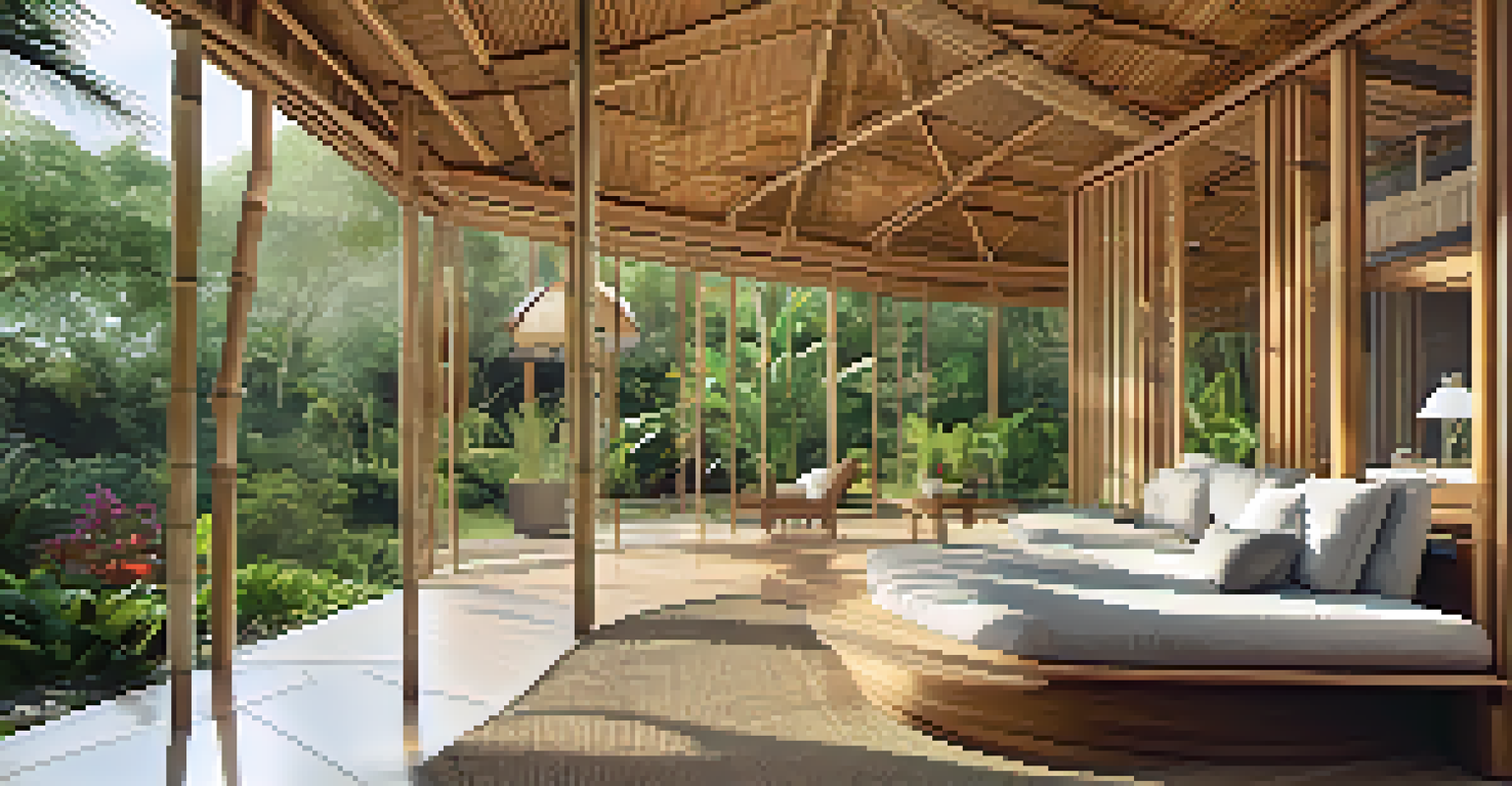Exploring the Use of Bamboo in Sustainable Construction

Introduction: What Makes Bamboo Sustainable?
Bamboo is often hailed as a miracle plant in the world of sustainable construction. Its rapid growth rate allows it to be harvested in just three to five years, making it a renewable resource. Unlike traditional trees, which can take decades to mature, bamboo’s ability to regenerate quickly makes it a more environmentally friendly option.
Bamboo is the most remarkable plant on earth. It is the only plant that can grow 3 feet in a day.
Additionally, bamboo requires minimal water and no chemical fertilizers or pesticides to thrive, further reducing its ecological footprint. This resilience means that bamboo can be cultivated in various climates, from tropical to temperate regions, making it a versatile choice for global construction needs. In essence, bamboo not only grows rapidly but also thrives with fewer resources, presenting a compelling case for its use in sustainable buildings.
When used in construction, bamboo can significantly lower carbon emissions compared to conventional materials. By incorporating bamboo into building practices, we not only support sustainable forestry but also contribute to a greener planet.
Structural Benefits of Bamboo in Construction
One of the standout features of bamboo is its impressive strength-to-weight ratio. When properly treated, bamboo can rival traditional building materials like steel and concrete. This unique characteristic allows architects and builders to design lighter structures without sacrificing durability, which can lead to lower transportation costs and easier construction.

Moreover, bamboo's flexibility makes it an excellent choice for earthquake-prone areas. Its natural ability to bend without breaking provides a level of resilience that can protect buildings during seismic events. This is particularly beneficial in countries where earthquakes are common, highlighting bamboo’s potential as a lifesaving building material.
Bamboo: A Fast-Growing Resource
Bamboo can be harvested in just three to five years, making it a highly renewable and sustainable building material.
Due to its lightweight nature, bamboo can also simplify construction processes, allowing for quicker assembly and reduced labor costs. As builders look for efficient ways to meet growing demands for sustainable housing, bamboo stands out as an innovative solution.
The Role of Bamboo in Eco-Friendly Architecture
Eco-friendly architecture emphasizes sustainability and minimal environmental impact, and bamboo fits perfectly into this paradigm. With its natural aesthetic, bamboo enhances the visual appeal of buildings while promoting harmony with the environment. Its unique texture and color can create stunning design elements that blend seamlessly with nature.
The future will be green, or not at all.
Architects are increasingly exploring innovative designs that showcase bamboo’s structural capabilities. From open-air pavilions to multi-story homes, bamboo allows for creative expressions that traditional materials may not support. This flexibility encourages more architects to think outside the box, pushing the boundaries of sustainable design.
Furthermore, the use of bamboo aligns with the principles of biophilic design, which seeks to connect people with nature. By incorporating natural materials like bamboo, architects can create spaces that enhance wellbeing and foster a deeper appreciation for the environment.
Challenges and Considerations in Bamboo Construction
While bamboo holds great promise, there are challenges that builders must navigate. One significant concern is the lack of standardized practices for treating and processing bamboo. Without proper treatment, bamboo can be susceptible to pests and rot, which can compromise the longevity of structures.
Additionally, there is still a limited availability of skilled labor specifically trained in bamboo construction techniques. As demand for bamboo increases, investing in education and training programs will be essential to ensure that builders can effectively work with this material. This gap in expertise can hinder the widespread adoption of bamboo in mainstream construction.
Strength and Flexibility Benefits
Bamboo's impressive strength-to-weight ratio and natural flexibility make it an ideal choice for lightweight and earthquake-resistant structures.
Lastly, potential buyers and clients may still need to be educated about the benefits of bamboo as a building material. Raising awareness about its strengths and advantages will be crucial in overcoming skepticism and promoting its use in sustainable projects.
Innovative Bamboo Projects Around the World
Globally, innovative projects are showcasing the versatility of bamboo in construction. For instance, the Green School in Bali, Indonesia, features stunning bamboo structures that emphasize sustainability and community. This school not only highlights bamboo's aesthetic appeal but also serves as an educational tool for students, teaching them about environmental stewardship.
Another remarkable project is the Bamboo House in Vietnam, designed to withstand the region’s tropical climate. This structure uses local bamboo to create a beautiful, functional home that integrates seamlessly with its surroundings. Projects like these demonstrate how bamboo can be used creatively while still meeting practical needs.
These examples inspire architects and builders worldwide to consider bamboo as a viable option for sustainable construction. As more projects emerge, the momentum for bamboo in the construction industry continues to grow.
The Future of Bamboo in Sustainable Construction
Looking ahead, the future of bamboo in sustainable construction appears bright. As environmental concerns escalate, the demand for eco-friendly materials will likely increase. Bamboo is already gaining traction in various markets, and as awareness spreads, its popularity could soar.
Innovations in treatment and processing techniques will also enhance bamboo's viability as a construction material. Research into improving durability and resistance to pests will address current challenges, making bamboo a more attractive option for builders and developers.
Challenges in Bamboo Construction
Despite its advantages, bamboo construction faces challenges like a lack of standardized practices and skilled labor, which need to be addressed for wider adoption.
Ultimately, the continued exploration of bamboo's potential could revolutionize the construction industry. By embracing this remarkable plant, we can pave the way for a more sustainable future, reducing our reliance on traditional materials that often harm the environment.
Conclusion: Embracing Bamboo for a Greener Tomorrow
In conclusion, bamboo stands out as a sustainable solution for modern construction challenges. Its rapid growth, strength, and aesthetic appeal make it an excellent choice for eco-friendly architecture. By embracing bamboo, we can reduce our environmental impact while creating beautiful, functional spaces.
As more architects and builders recognize the benefits of bamboo, we can expect to see its integration into various projects worldwide. This shift towards sustainable practices not only benefits the planet but also enhances the quality of life for those who inhabit these spaces.

Together, we can champion bamboo as a game changer in the construction industry, contributing to a greener, more sustainable tomorrow. It’s time to rethink our building materials and consider the incredible potential of bamboo.